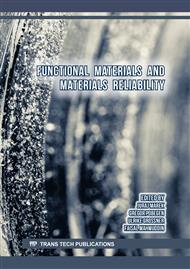[1]
Bechtold, T., and Pham, T., Textile Chemistry, De Gruyter, Berlin, 2019.
Google Scholar
[2]
Mendes, I. S. F., Prates, A., and Evtuguin, D. v., Production of rayon fibres from cellulosic pulps: State of the art and current developments, Carbohydr Polym 273 (2021).
DOI: 10.1016/j.carbpol.2021.118466
Google Scholar
[3]
Tuteja, S., and Birla, J. D., Effect of Formic Acid Pretreatment on the Dyeing of Bamboo Fabric, Article in Journal of the Textile Association (2022).
Google Scholar
[4]
Samanta, A. K., Effects of Acid/Alkali and Cellulase Enriched Mixed Enzyme Treatments on Properties of Jute-Cotton Union Furnishing Fabric, Journal of Textile Engineering & Fashion Technology 1 (2017).
DOI: 10.15406/jteft.2017.01.00011
Google Scholar
[5]
Moses, J., and Gnana Priya, K., Comparative Study between Modal and Cotton after Formic Acid Treatment, International Journal of Innovative Research in Science 6 (2017).
Google Scholar
[6]
Moses, J., and Gnana Priya, K., A Study on Modal Fabric using Formic Acid Treatment for K/S, SEM and Fourier Transform Infrared Spectroscopy, Oriental Journal of Chemistry 32 (2016) 1099–1110.
DOI: 10.13005/ojc/320235
Google Scholar
[7]
Gnana Priya, K., and Jeyakodi Moses, J., Assessment of anti-bacterial effect, antiodoureffect, uv- protection factor and xrd on formic acid treated modal and cotton fabric., CIKITUSI JOURNAL FOR MULTIDISCIPLINARY RESEARCH 6 (2019) 467–479.
DOI: 10.9734/bpi/cacs/v6/5306f
Google Scholar
[8]
Capellino, S., and Cassani, N., Producción de Ácido Fórmico, Universidad Tecnológica Nacional , (2021).
Google Scholar
[9]
Lima, M., Ferreira Da Silva, L., Vasconcelos, R., and Cunha, J., FRICTORQ, DESIGN FOR THE OBJECTIVE MEASUREMENT OF FRICTION IN 2D SOFT SURFACES.
Google Scholar
[10]
Lima, M., Silva, L. F., Vasconcelos, R., Martins, J., and Hes, L., FRICTORQ, TRIBÓMETRO PARA AVALIAÇÃO OBJECTIVA DE SUPERFÍCIES TÊXTEIS (2006).
Google Scholar
[11]
Lima, M., Vasconcelos, R., Abreu, M., and Cabeço Silva, M., COMPARATIVE STUDY OF FRICTION COEFFICIENT IN NONWOVENS USING FRICTORQ, FABRIC FRICTION TESTER.
Google Scholar
[12]
Ahmed, N., Oulton, D. P., and Taylor, J. A., The use of reflectance measurements in the determination of fixation of reactive dyes to cotton, Color Res Appl 31 (2006) 117–121.
DOI: 10.1002/col.20189
Google Scholar
[13]
Padrão, J., Nicolau, T., Felgueiras, H. P., Calçada, C., Veiga, M. I., Osório, N. S., et al., Development of an Ultraviolet-C Irradiation Room in a Public Portuguese Hospital for Safe Re-Utilization of Personal Protective Respirators, Int J Environ Res Public Health 19 (2022) 4854.
DOI: 10.3390/ijerph19084854
Google Scholar
[14]
Lelekakis, N., Wijaya, J., Martin, D., and Susa, D., The effect of acid accumulation in power-transformer oil on the aging rate of paper insulation, IEEE Electrical Insulation Magazine 30 (2014) 19–26.
DOI: 10.1109/mei.2014.6804738
Google Scholar
[15]
Wang, J., and Liu, J., Surface modification of textiles by aqueous solutions, in Surface Modification of Textiles, (Elsevier, 2009), 269–295.
DOI: 10.1533/9781845696689.269
Google Scholar
[16]
Palme, A., Theliander, H., and Brelid, H., Acid hydrolysis of cellulosic fibres: Comparison of bleached kraft pulp, dissolving pulps and cotton textile cellulose, Carbohydr Polym 136 (2016) 1281–1287.
DOI: 10.1016/j.carbpol.2015.10.015
Google Scholar
[17]
Girisuta, B., Janssen, L. P. B. M., and Heeres, H. J., Kinetic Study on the Acid-Catalyzed Hydrolysis of Cellulose to Levulinic Acid, Ind Eng Chem Res 46 (2007) 1696–1708.
DOI: 10.1021/ie061186z
Google Scholar
[18]
Fan, L., Gharpuray, M. M., and Lee, Y.-H., Acid Hydrolysis of Cellulose, in 1987), p.121–148.
Google Scholar
[19]
Merkel, R. S., Analytical methods for a textile laboratory, in Methods for Analyzing Damage in Textile Materials, ed. Weaver, J. W., 3rd ed., American Association of Textile Chemists and Colorists, 1984.
DOI: 10.1177/004051755102100318
Google Scholar
[20]
Sun, Y., Lin, L., Pang, C., Deng, H., Peng, H., Li, J., et al., Hydrolysis of Cotton Fiber Cellulose in Formic Acid, Energy & Fuels 21 (2007) 2386–2389.
DOI: 10.1021/ef070134z
Google Scholar
[21]
Xiong, R., Zhang, X., Tian, D., Zhou, Z., and Lu, C., Comparing microcrystalline with spherical nanocrystalline cellulose from waste cotton fabrics, Cellulose 19 (2012) 1189–1198.
DOI: 10.1007/s10570-012-9730-4
Google Scholar
[22]
Emam, H. E., Generic strategies for functionalization of cellulosic textiles with metal salts, Cellulose 26 (2019) 1431–1447.
DOI: 10.1007/s10570-018-2185-5
Google Scholar
[23]
Mohapatra, S., Sterilization and Disinfection, in Essentials of Neuroanesthesia, Elsevier, 2017.
Google Scholar


